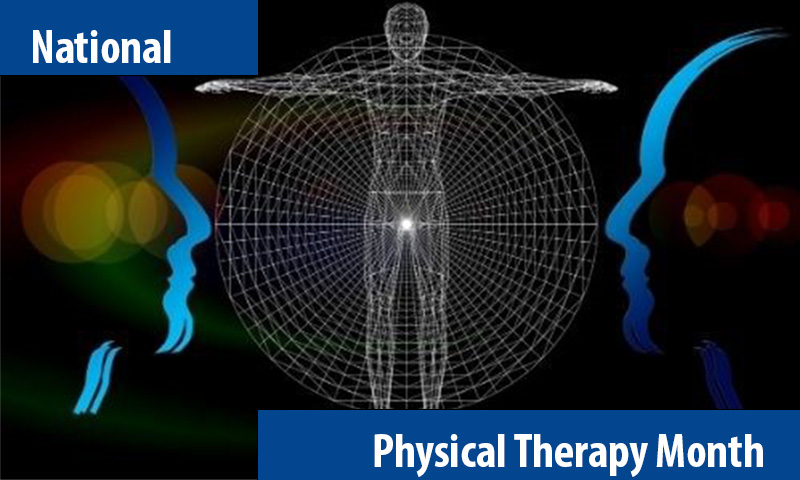October is National Physical Therapy Month.
This year, the topic chosen by the APTA is #ChoosePT.
So what is #ChoosePT?
“It is about raising awareness about physical therapy and what physical therapy can do for you.”
Whether you are recovering from a surgery, are experiencing balance and gait deficits, have weakness or pain from another injury, physical therapy can help. Movement is crucial to a person’s health, quality of life and independence.
“For some people, pain makes movement a challenge. Pain is one of the most common reasons people seek health care. A physical therapist (PT) can help people move better and safely, and manage their pain.”
Why Physical Therapy?
PTs are movement experts who improve quality of life through prescribed exercise, hands-on care and patient education. PTs treat people of all ages and abilities and empower them to actively take part in their own care.
Other reasons to #ChoosePT
-
Live your Best Life
-
Individualized treatment
-
Prevent or improve many chronic conditions
a. COVID
b. Heart Disease
c. Diabetes
d. Obesity
e. Cancer
f. Chronic Fatigue Syndrome
g. Headaches
-
Manage pain, avoid surgery, and minimize use of prescription drugs
a. Low Back Pain
b. Chronic Painc.
c. COPD
d. Osteoarthritis of a joint
e. Neck Pain
f. Herniated Disc
g. Dry Needling for Pain
-
Recover from and Prevent Injury
a. ACL Tear
b. Fall prevention
c. Achilles Tendinopathy
d. Shin Splints
e. Labral Tear
f. Rotator Cuff Tear
6. Improve your own Movement and Fitness
7. Participation in your own care
APTA. https://www.choosept.com/
The Centers for Disease Control and Prevention (CDC) recommends safe alternatives like physical therapy for the management of most non–cancer-related pain.
What does the Research say about Physical Therapy?
- The CDC recommends nonopioid approaches for chronic pain. In March 2016, CDC released guidelines urging clinicians to consider opioid therapy, “[O]nly if expected benefits for both pain and function are anticipated to outweigh the risks to the patient.”
- Physical therapists help individuals experiencing frailty and debility restore their strength, flexibility, endurance, balance, and overall mobility. We also help people reduce their chronic pain, and improve their daily function. 1
- Telehealth visits are available for established patients.
- Increase oxygenation and recovery post mechanical ventilation for COVID-19 affected patients.
- According to the 2018 study by Zhang et al., early mobilization in the ICU exerts a positive and safe effect on hospital outcomes for patient who require mechanical ventilation (MV) because it confers the signification benefit from decreasing the duration of MB and the length of stay in the ICU.3,16
- Several observational studies involving patients with acute respiratory failure have demonstrated that early PT programs are both safe and feasible.2,4-7, 21-22
- Physical therapy in the ICU appears to confer significant benefit in improving quality of life, physical function, peripheral and respiratory muscle strength, increasing ventilator-free days, and decreasing hospital and ICU stay.4
- Interpretation of (A) strategy for whole-body rehabilitation-consisting of interruption of sedation with physical and occupation therapy in the earliest days of critical illness-was safe and well tolerated, and resulted in better functional outcomes at hospital discharge- a shorter duration of delirium, and more ventilator-free days compared with standard care.5
- Help patients (COVID-19 related or from stay at home orders) recover from deconditioned status.
-
- In the same year, a study by Nydahl reported that early mobilization and physical rehabilitation for critically ill patients appear to be safe and have a low risk of potential adverse events.3,8,9,15
- Physical therapy improves multiple aspects of physical function, including muscle strength, endurance, and the performance of functional activities. 2,9,10
-
- Older adults with mobility and frailty problems are able to safely increase physical activity in their own environment and reduce frailty. This study emphasizes both the potential cost-effectiveness of a patient-centered approach in the frail elderly and the importance of physical activity promotion in older adults with mobility limitations.6,7
- There is an indication that relatively long-lasting and high-intensive multicomponent exercise programs have a positive effect on ADL and IADL disability for community-living moderately physically frail older persons.7
- During bed rest muscle mass decreases at a rate of 1-2% per day.8
- Exercise programs should be individualized based on muscle strength, cardiovascular function, and balance and gait parameters. Emphasis should be placed on most significant deficits and the goals of the participant. A multidimensional exercise program should be implemented to prevent the deleterious effects of deconditioning. 9
- For many older adults transitioning from the hospital to home settings, physical therapists are the right provider at the right time to assess and address post-hospitalization physical and functional deficits.10,22 Such approaches may contribute to reducing hospital readmissions, improving overall medical outcomes, and subsequently decreasing health care costs.
- Older adults with mobility problems are able to safely increase physical activity in their own environment and reduce faulty. 11
- There are recommended therapeutic activities and intensities for frail older adults to increase physical activity and improve general health and well being, as well as reduce the risk of falls and manage chronic lifestyle conditions.12
- Physical therapy and physical activity can reduce the risk of falls, and promote cognitive health and self-management of chronic diseases. It can slow the deterioration in ability to perform ADLs and maintain quality of life in older adults. A meta-analysis found that exercise is beneficial to improve balance, gait speed and abilities to carry out ADLs in the frail older adult population.12
- Physical therapists should play a large role in establishing appropriate and individualized exercise programs, as they have considerable experience in providing exercise therapy in the context of medical care for elderly people with varying conditions and risks.14
References:
1. APTA. Physical Therapy Guide to Frailty and Debility. May 25, 2011. Accessed May 18, 2020.
2. Bein T, Weber-Carstens S, Apfelbacher C. Long-term outcome after the acute respiratory distress syndrome: different from general critical illness?. Curr Opin Crit Care. 2018;24(1):35‐40. doi:10.1097/MCC.0000000000000476.
3. Pawlik AJ, Kress JP. Issues affecting the delivery of physical therapy services for individuals with critical illness. Phys Ther. 2013;93(2):256-65. https://login.ezproxy.fgcu.edu/login?url=https://search-proquest-com.ezproxy.fgcu.edu/docview/1314722572?accountid=10919. doi: http://dx.doi.org.ezproxy.fgcu.edu/10.2522/ptj.20110445.
4. Moss M, Nordon-Craft A, Malone D, et al. A randomized trial of an intensive physical therapy program for patients with acute respiratory failure. American Journal of Respiratory and Critical Care Medicine. 2016;193(10):1101-1110. https://login.ezproxy.fgcu.edu/login?url=https://search-proquest-com.ezproxy.fgcu.edu/docview/1789279971?accountid=10919. doi: http://dx.doi.org.ezproxy.fgcu.edu/10.1164/rccm.201505-1039OC.
5. Bailey P, Thomsen GE, Spuhler VJ, Blair R, Jewkes J, Bezdjian L, Veale K, Rodriquez L, Hopkins RO. Early activity is feasible and safe in respiratory failure patients. Crit Care Med 2007;35: 139-145.
6. Morris PE, Goad A, Thompson C, Taylor K, Harry B, Passmore L, Ross A, Anderson L, Baker S, Sanchez M, et al. Early intensive care unit mobility therapy in the treatment of acute respiratory failure. Crit Care Med 2008;36:2238-2243.
7. Nordon-Craft A, Schenkman M, Ridgeway K, Benson A, Moss M. Physical therapy management and patient outcomes following ICUacquired weakness: a case series. J Neurol Phys Ther 2011;35: 133-140.
8. Zhang L, Hu W, Cai Z, et al. Early mobilization of critically ill patients in the intensive care unit: A systematic review and meta-analysis. PLoS One. 2019;14(10). https://login.ezproxy.fgcu.edu/login?url=https://search-proquest-com.ezproxy.fgcu.edu/docview/2300608357?accountid=10919. doi: http://dx.doi.org.ezproxy.fgcu.edu/10.1371/journal.pone.0223185.
9. Nydahl P, Sricharoenchai T, Chandra S, Kundt FS, Huang M, Fischill M, et al. Safety of Patient Mobilization and Rehabilitation in the Intensive Care Unit. Systematic Review with Meta-Analysis. Ann Am Thorac Soc. 2017; 14(5): 766–777. pmid:28231030
10. Escalante A, Miller L, Beardmore TD. Resistive exercise in the rehabilitation of polymyositis/dermatomyositis. J Rheumatol 1993; 20:1340-1344.
11. de Vries NM, Staal JB, van der Wees PJ, et al. Patient-centred physical therapy is (cost-) effective in increasing physical activity and reducing frailty in older adults with mobility problems: a randomized controlled trial with 6 months follow-up. J Cachexia Sarcopenia Muscle. 2016;7(4):422‐435.
12. Powers CM. Deconditioning Prevention. 2nd. ed. ed. New York: Springer Publishing Company; 2008:4-202,R23. https://login.ezproxy.fgcu.edu/login?url=https://search-proquest-com.ezproxy.fgcu.edu/docview/189415215?accountid=10919.
13. Daniels R, van Rossum E, de Witte L, Kempen GI, van den Heuvel W. Interventions to prevent disability in frail community-dwelling elderly: a systematic review. BMC Health Serv Res. 2008;8:278. Published 2008 Dec 30. doi:10.1186/1472-6963-8-278
14. Flavey JR, Burke RE, Malone D, Ridgeway KJ, McManus BM, Stevens-Lapsley JE. Role of Physical Therapists in Reducing Hospital Readmissions: Optimizing Outcomes for Older Adults During Care Transitions From Hospital to Community, Physical Therapy, Volume 96, Issue 8, 1 August 2016, Pages 1125–1134, https://doi.org/10.2522/ptj.20150526.
15. Falvey JR, Mangione KK, Stevens-Lapsley JE. Rethinking hospital-associated deconditioning: proposed paradigm shift. Phys Ther. 2015; 95: 1307–1315.
16. Frail Elderly: The Physiotherapist’s Role in Preventing Hospital Admission. (2020, January 17. Physiopedia, . Retrieved 18:27, May 19, 2020 from https://www.physio-pedia.com/index.php?title=Frail_Elderly:_The_Physiotherapist%27s_Role_in_Preventing_Hospital_Admission&oldid=228618.
17. Department of Health. Start active, stay active: report on physical activity in the UK. https://www.gov.uk/government/publications/start-active-stay-active-a-report-on-physical-activity-from-the-four-home-countries-chief-medical-officers (accessed 18 May 2020).
18. The British Heart Foundation National Centre for Physical Activity and Health. Interpreting the UK physical activity guidelines for older adults in transition. http://www.bhfactive.org.uk/older-adults-resources-and-publications-item/39/429/index.html (accessed 18 May 2020).
19. The British Heart Foundation National Centre for Physical Activity and Health. Interpreting the UK physical activity guidelines for frailer older adults. http://www.bhfactive.org.uk/resources-and-publications-item/39/430/index.html (accessed 18 May 2020).
20. Stares A, Bains M. The Additive Effects of Creatine Supplementation and Exercise Training in an Aging Population: A Systematic Review of Randomized Controlled Trials. Journal of geriatric physical therapy (2001). 2019 Feb.
21. Kohei M, Yoshiteru A. Role of Physical Therapists in Health Care of the Elderly, Nippon Eiseigaku Zasshi (Japanese Journal of Hygiene), 2016, Volume 71, Issue 2, Pages 126-132, Released May 27, 2016. https://doi.org/10.1265/jjh.71.126.
22. Apta. https://www.choosept.com/toolkit


